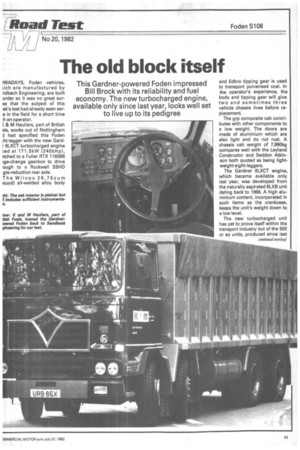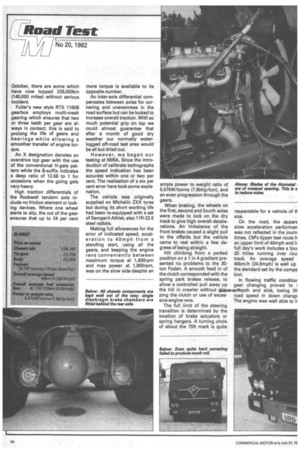The old block itself
Page 33

Page 34

Page 35

Page 36

If you've noticed an error in this article please click here to report it so we can fix it.
This Gardner-powered Foden impressed Bill Brock with its reliability and fuel economy. The new turbocharged engine, available only since last year, looks well set to live up to its pedigree
IWADAYS, Foden vehicles, lich are manufactured by ndbach Engineering, are built order so it was no great surse that the subject of this ek's test had already seen sere in the field for a short time :h an operator.
& M Hauliers, part of British 31s, works out of Nottingham had specified this Foden Iht-legger with the new Gardr 6LXCT turbocharged engine ted at 171.5kW (2 40bhp), itched to a Fuller RTX 11609B ige-change gearbox to drive ough to a Rockwell SSHD gle-reduction rear axle.
The Wilcox 2 6.7 5cum icuyd) all-welded alloy body and Edbro tipping gear is used to transport pulverised coal. In the operator's experience, the body and tipping gear will give two and sometimes three vehicle chassis lives before replacement.
The grp composite cab contributes with other components to a low weight. The doors are made of aluminium which are also light and do not rust. A chassis cab weight of 7,880kg compares well with the Leyland Constructor and Seddon Atkinson both quoted as being lightweight eight-leggers.
The Gardner 6LXCT engine, which became available only last year, was developed from the naturally aspirated 6LXB unit dating back to 1966. A high aluminium content, incorporated in such items as the crankcase, keeps the unit's weight down to a low level.
The new turbocharged unit has yet to prove itself within the transport industry but of the 500 or so units, produced since last October, there are some which have now topped 226,000km (140,000 miles) without serious incident.
Fuller's new style RTX 1160B gearbox employs multi-mesh gearing which ensures that two or three teeth per gear are always in contact; this is said to prolong the life of gears and bearings while allowing a smoother transfer of engine torque.
An X designation denotes an overdrive top gear with the use of the conventional H-gate pattern while the B-suffix indicates a deep ratio of 12.56 to 1 for occasions when the going gets very heavy.
High traction differentials of the Rockwell tandem axle include no friction element or locking devices. Where one wheel starts to slip, the cut of the gear ensures that up to 24 per cent more torque is available to its opposite number.
An inter-axle differential compensates between axles for cornering and unevenness in the road surface but can be locked to increase overall traction. With so much potential grip on tap we could almost guarantee that after a month of good dry weather our normally waterlogged off-road test area would be all but dried out.
However, we began our testing at MIRA. Since the introduction of calibrate tachographs the speed indication has been accurate within one or two per cent. The realisation of a six per cent error here took some explanation.
The vehicle was originally supplied on Michelin ZXX tyres but during its short working life had been re-equipped with a set of Semperit Athlet, also 11R-22.5 steel radials.
Making full allowances for the error of indicated speed, acceleration to 4 Omph from a standing start, using all the gears, and keeping the engine revs conveniently between maximum torque at 1,400rpm and max power at 1,900rpm, was on the slow side despite an ample power to weight ratio of 5.57kW/tonne (7.6bhp/ton), and an even progression through the gears.
When braking, the wheels on the first, second and fourth axles were made to lock on the dry track to give high overall decelerations. An imbalance of the front brakes caused a slight pull to the offside but the vehicle came to rest within a few degrees of being straight.
Hill climbing from a parked position on a 1 in 4 gradient presented no problems to the 30ton Foden. A smooth feed in of the clutch corresponded with the spring park brakes release, to allow a controlled pull away up the hill in crawler without 440., ping the clutch or use of excessive engine revs.
The full limit of the steering transition is determined by the location of brake actuators or spring hangers. A turning circle of about the 75ft mark is quite respectable for a vehicle of ti size.
On the road, the apparE slow acceleration performan was not reflected in the journ times. CM's tipper test route h an upper limit of 40mph and ir full day's work includes a tow 20 miles running over rou! track. An average speed 40km/h (24.9mph) is well up the standard set by the compe tion.
In flowing traffic conditior gear changing proved to I 4.sittooth and slick, losing lit road speed in down changE The engine was well able to It own to about 1,000rpm but for le most part was made to work t speeds above that at which iaximum torque occurred. The verall fuel consumption of 47.7 t/100km (5.92mpg) does not ead the list as the best of the K4s driven over this route but Dmes close to it.
The steering was light without sing vague and gave good feel I the road. Mid-way through re test a precautionary inspecon of the vehicle found th& the heels of both front axles had acome loose. They had been ainted in the operator's livery ler leaving the factory and aint applied beneath the coned uts had fractured. We were ble to borrow a torque spanner rid reset the nuts to the reuired 350Ibft. If any component is likely to fall off, the rough road section will find it out. Unfortunately for us, the lockable fuel cap did just this and it was several miles before we realised that fuel was splashing out of the filler. We had to begin the fuel consumption runs again.
From inside the cab, excellent all-round visibility through the tinted front screen end door windows was enhanced by the side windows to the rear of the seats which made it possible to see approaching traffic at acute road junctions, while a kerb mirror above the mate's door gave vision close to the near side front wheel.
To gain entry to his seat the driver must climb two steps; but the position of the grab handles adds an extra degree of leverage making the exercise easier and safer than it might be without them.
Internal trim has undergone a few minor changes with a re-positioned radio (now 24 volts) and the removal of the central flask holder. A two-spoked steering wheel allows adequate vision of the instrumentation panel which is well equipped with relevant guages and the tachograph and tachometer in the most promiment positions. An improved method of attachment is needed to retain the steering wheel spoke cover.
Correctly set, the suspension seat softened the road shock transmitted up through the front Suspension. At the rear, Foden FF20 dual-rate rubber suspension, fitted as standard, contributed to the smooth ride which, even when driven quite hard into corners, also resisted excessive roll.
Ground clearance below axle level is clear of obstruction. Heavy I-beam sections, carrying the two rear-axles, might improve flotation under difficult muddy operational conditions but it may be that at this depth limits of available traction would have already been surpassed.
To the rear, Sandbach Engineering incorporates a tipping hinge bar as part of the chassis, while behind the axle, fitment of single diaphragm brake chambers allows clearance to back up onto soil heaps.
At the front end, a large front panel lifts high and clear of head height to expose oil filler dipstick, radiator and other daily check points. When pumped up to the maximum overcentre position, 65° of cab tilt allows walk-in access to the engine.
The gearstick needs no disconnection as it is allowed to pivot at its middle point. Unequal blade setting of the Alumetal fan is said to break up the noise frequency and give a quieter performance than for one with equally spaced blades. A big 0.56sqm (6sqft) radiator lessens the air flow demand to allow slower rotational speeds. Silicon rubber hoses are double clipped for security.
The turbocharger is an easily seen change from the former 6LXC engine but other differences are not so obvious. Pistons and rings are different. The mechanically driven oil pump has a greater throughput while the engine internals such as the valves, head, and con rods, give improved gas flow and withstand higher loadings.
Chassis wiring is contained in a conduit and the resettable contact breakers are housed within the cab below the dash.
Colour coded brake pipes make it a simple job to follow an individual line when fault-tracing.
The 6LXCT, the first of the Gardner turbocharged engines, is relatively new and untried by the transport industry but first impressions are that it will continue to promote the company's long reputation for reliability and fuel economy.
The light weight contributes to the low unladen weight of the Foden Haulmaster 5108. For tipper operation at 30 tons gross the power output of 171.5kW (230bhp) when matched to the Fuller FiTX 11608 range-change gearbox, with its deep crawler and overdrive top gears, is sufficient to provide both gradeability and iTiaximum speed suited to motorway running.
Sandbach Engineering, alone in offering rubber suspension as standard, finds few who take exception to it and specify the alternative.
The composite cab, divided internally by the high engine cover, has improved with age and is now quieter and better ergonomically than it was.
With the Foden S108, SEC is able to show some of the benefits that a relatively small volume vehicle builder can offer by using premium components.










































